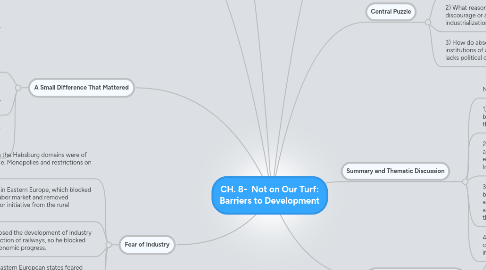CH. 8- Not on Our Turf: Barriers to Development
by Lana Dargan

1. A Small Difference That Mattered
1.1. 1) The critical juncture for Spain was the discovery of the Americas. The narrow, monopolized base of trade with the Americas meant that no broad class of merchants could emerge via trading opportunities with the colonies. *Whereas absolutism crumbled in England, it only grew stronger in Spain. Interestingly enough, absolutism in Spain led to the enrichment of the merchant class in England.
1.2. 2) The English defeat of absolutism in 1688 led to pluralistic political institutions and the further development of a more effective centralized state. This led to the creation of a modern, efficient tax bureaucracy.
1.3. 3) Spain failed to create secure property rights for entrepreneurs, monopolized trade, sold offices and made many of them hereditary, indulged in tax farming, and even sold immunity from justice.
2. Fear of Industry
2.1. 1) Merchants in the Habsburg domains were of little importance. Monopolies and restrictions on trade existed.
2.2. 2) Serfdom prevailed in Eastern Europe, which blocked the emergence of a labor market and removed economic incentives or initiative from the rural population.
2.3. 3) Francis I opposed the development of industry and the construction of railways, so he blocked industry and economic progress.
2.4. 4) The leaders of the Eastern European states feared the creative destruction unleashed by a modern industrial economy would undermine the political status quo.
2.5. 5) One more example: In the Kingdom of Kongo, people understood that whatever they produced could be confiscated by an absolutist monarch. Therefore, the people had no incentive to invest or to use better technology
3. Enduring Backwardness
3.1. Societies that lacked centralization in the 18th and 19th centuries were particularly disadvantaged in the age of industry.
3.2. Absolutism is not the only form of extractive political institutions and was not the only factor preventing industrialization.
3.2.1. Somalia illustrates what happens without some degree of political centralization to enforce law and order, uphold property rights, and encourage economic activity
4. Key Arguments and Conclusions
4.1. Elites almost always opposed any political centralization (they could lose power & privileges
4.2. The typical pattern of interaction (seen in previous centuries) between critical junctures and existing institutional differences leads again to further institutional and economic divergence
5. Central Puzzle
5.1. 1) Looks at how many countries that faced critical junctures after the Industrial revolution failed to take advantage of the spread of industry. These countries ended up with absolutist political and extractive institutions, or they lacked political centralization.
5.2. 2) What reasons did countries have to either discourage or actively block the spread of industrialization and new technologies?
5.3. 3) How do absolutist regimes affect the institutions of a country? What if the country lacks political centralization?
6. Summary and Thematic Discussion
6.1. No Printing Allowed
6.2. 1) Gutenberg’s invention of the printing press based on the movable type quickly spread through Western Europe
6.3. 2) The Ottoman Empire, China, and other absolutist regimes blocked or did nothing to encourage the spread of industry during the Industrial Revolution.
6.4. 3) The sultan of the Ottoman Empire did not allow the printing press to be used is because he feared the spread of ideas. Some of these ideas may be subversive and challenge the existing political and social status quo. The Ottoman sultans and religious establishment feared the creative destruction that would result from the use of the printing press.
6.5. 4) Absolutism and a lack of, or weak, political centralization are two barriers to the spread of industry.
7. The Absolutism of Prester John
7.1. With no pluralistic institutions or checks and constraints on the power of the emperor, Ethiopia was a prime example of absolutism.
7.2. led to severe insecurity of property rights driven by the political strategy of the emperor
7.3. Ethiopia is one of the poorest countries in the world today because absolutism persisted until the recent past.
8. Critique and Questions
8.1. The authors acknowledge that limited growth can occur under extractive institutions as long as there is political centralization, however if we look at China, aren’t their institutions still largely extractive? Yet they are experiencing continued growth.. how does that work?
8.2. It's hard to distinguish between no political centralization and some/little political centralization. Isn't it true that some level of centralization (even if small) takes place in all systems?


